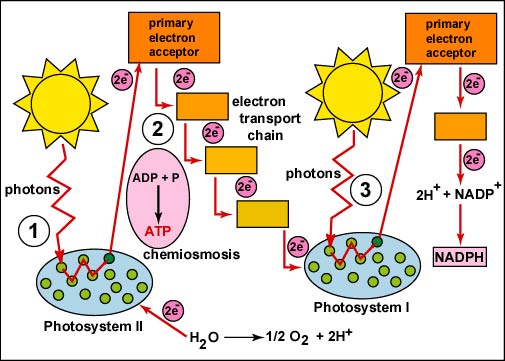
1. As photons are absorbed by pigment molecules in the antenna complexes of Photosystem II, excited electrons from the reaction center are picked up by the primary electron acceptor of the Photosystem II electron transport chain. During this process, Photosystem II splits molecules of H2O into 1/2 O2, 2H+, and 2 electrons. These electrons continuously replace the electrons being lost by the P680 chlorophyll a molecules in the reaction centers of the Photosystem II antenna complexes.
2. During this process, ATP is generated by the Photosystem II electron transport chain and chemiosmosis. According to the chemiosmosis theory, as the electrons are transported down the electron transport chain, some of the energy released is used to pump protons across the thylakoid membrane from the stroma of the chloroplast to the thylakoid interior space producing a proton gradient or proton motive force. As the accumulating protons in the thylakoid interior space pass back across the thylakoid membrane to the stroma through ATP synthetase complexes, this proton motive force is used to generate ATP from ADP and Pi.
3. Meanwhile, photons are also being absorbed by pigment molecules in the antenna complex of Photosystem I and excited electrons from the reaction center are picked up by the primary electron acceptor of the Photosystem I electron transport chain. The electrons being lost by the P700 chlorophyll a molecules in the reaction centers of Photosystem I are replaced by the electrons traveling down the Photosystem II electron transport chain. The electrons transported down the Photosystem I electron transport chain combine with 2H+ from the surrounding medium and NADP+ to produce NADPH + H+.